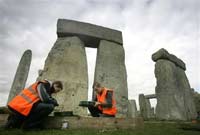|
|

|
|
In this Monday March 31, 2008 file photo, archaeology students Steve Bush, right, and Sam Ferguson, left, sieve through earth amongst the stones at Stonehenge, England.
|
Archaeologists probing the secrets of Stonehenge, Britain's most famous prehistoric monument, said on Monday it may have been an ancient pilgrimage site for the sick who believed its stones had healing qualities.
It has always been a mystery why bluestones, the smaller stones that form part of the circle, were transported around 155 miles from Preseli Hills in Wales to Wiltshire in southern England.
Archaeologists from Bournemouth University, who carried out the dig in April -- the first at Stonehenge since 1964 -- believe the bluestones were revered as healing stones.
"It was the magical qualities of these stones which ... transformed the monument and made it a place of pilgrimage for the sick and injured of the Neolithic world," a statement from the archaeologist team said.
Geoffrey Wainwright, president of the Society of Antiquaries of London and one of the experts leading the work, told BBC radio that one reason which lead to the conclusion was because a number of the burials around Stonehenge showed signs of trauma and deformity.
The archaeologists said in the statement that radio-carbon dating put the construction of the circle of bluestones at between 2,400 B.C. and 2,200 B.C., a few centuries later than originally thought.
But they found fragments of charcoal dating from before 7,000 B.C., showing humans were active in the area much earlier than previously thought.
During the excavation at the World Heritage Site on Salisbury Plain, the researchers also found a beaker pottery fragment, Roman ceramics and ancient stone hammers.
"We now know, much to our surprise and delight, that Stonehenge was not just a prehistoric monument, it was a Roman and mediaeval monument," said Wainwright.
Another of the team leaders, Tim Darvill of Bournemouth University, said the bluestones appeared central to the purpose of Stonehenge although it may have had more than one function.
Other theories about Stonehenge are that it was a religious site or that it acted as a calendar.
点击查看更多双语新闻
(Agencies)
|
考古学家们于本周一公布,英国最著名的史前遗址巨石阵可能是古代病人的朝圣地。据推测,巨石阵的石头可能被史前人类当作是具有治疗功效的幸运石。
长期以来,人们一直很困惑,为什么巨石阵里的一种蓝色小石头是从155英里以外的威尔士普利斯里山运到英格兰南部威尔特郡这里的。
伯恩茅斯大学的考古学家们推测,可能当时的人们信奉这些蓝色的石头具有神奇疗效。考古学家于今年4月对史前巨石阵进行了自1964年以来的首次发掘。
该考古小组在一份声明中说:“巨石阵曾经可能只是个纪念碑,但这些具有魔力的石头被搬来之后,这里就变成了新时器时代伤病者的朝圣地。”
伦敦古文物学会主席、考古小组专家杰弗里•韦恩莱特在接受BBC广播的采访时说,得出这一结论的其中一个根据就是,巨石阵附近埋葬了很多伤残者。
考古学家在一份声明中说,经放射性碳测年法鉴定,环形巨石阵应该建造于公元前2400年至公元前2200年之间,比之前的推测晚了几百年。
但考古学家还在此发现了公元前七千年前的木炭碎片,这说明在更早的时期已有人类活跃在这一地带。
考古人员还在发掘过程中发现了大口陶器杯的碎片、古罗马陶器以及古石锤。位于索尔兹伯里平原的史前巨石阵已被列入世界文化遗址。
韦恩莱特说:“现在我们知道了,巨石阵不仅是史前的纪念碑,也是古罗马和中世纪时期的祭坛,这个发现让我们十分惊喜。”
考古小组的另一位专家、伯恩茅斯大学的蒂姆•达维尔说,巨石阵可能有多种功能,但蓝色小石头应该是其功能的一个重要体现。
其它理论认为,巨石阵曾是个宗教场所或是一个日历等等。
(英语点津姗姗编辑)
|